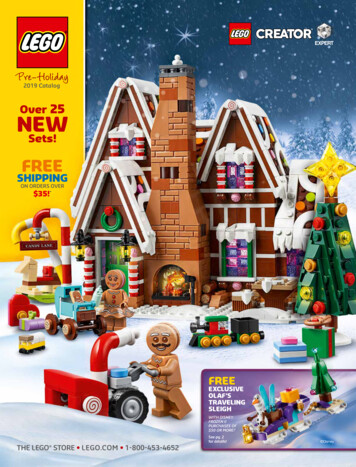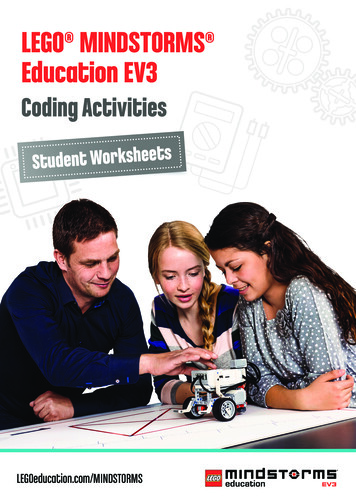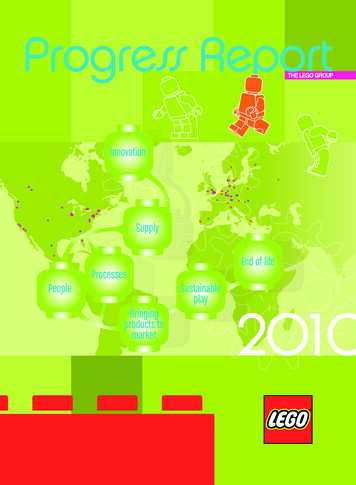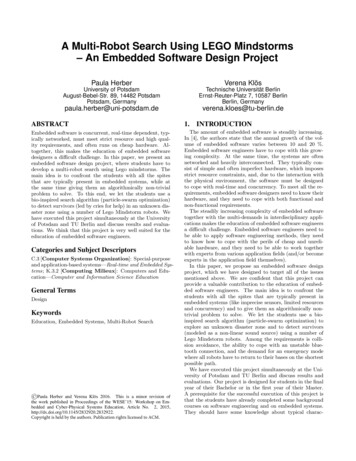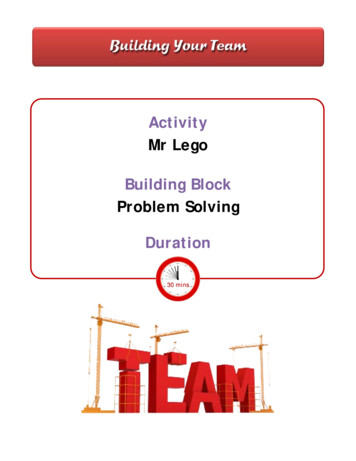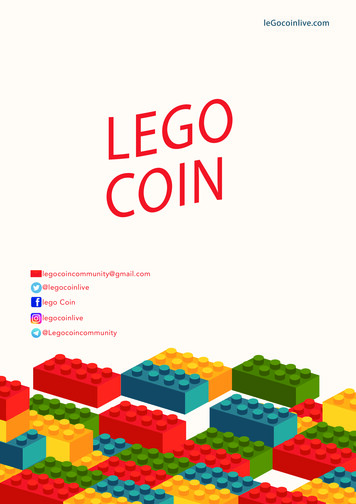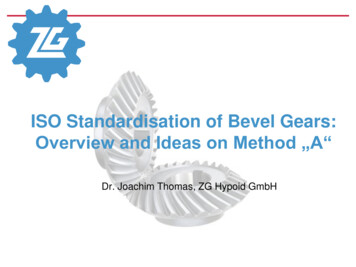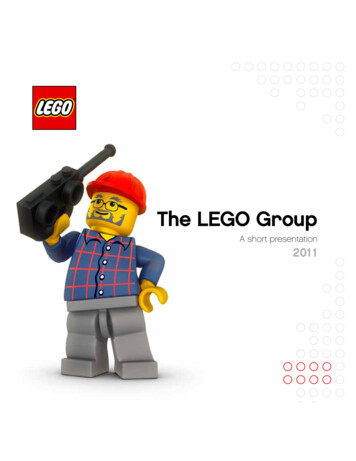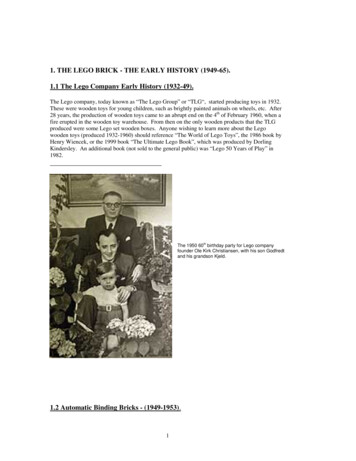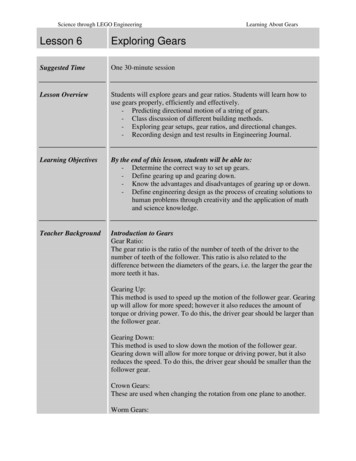
Transcription
Science through LEGO EngineeringLearning About GearsLesson 6Exploring GearsSuggested TimeOne 30-minute sessionLesson OverviewStudents will explore gears and gear ratios. Students will learn how touse gears properly, efficiently and effectively.- Predicting directional motion of a string of gears.- Class discussion of different building methods.- Exploring gear setups, gear ratios, and directional changes.- Recording design and test results in Engineering Journal.Learning ObjectivesBy the end of this lesson, students will be able to:- Determine the correct way to set up gears.- Define gearing up and gearing down.- Know the advantages and disadvantages of gearing up or down.- Define engineering design as the process of creating solutions tohuman problems through creativity and the application of mathand science knowledge.Teacher BackgroundIntroduction to GearsGear Ratio:The gear ratio is the ratio of the number of teeth of the driver to thenumber of teeth of the follower. This ratio is also related to thedifference between the diameters of the gears, i.e. the larger the gear themore teeth it has.Gearing Up:This method is used to speed up the motion of the follower gear. Gearingup will allow for more speed; however it also reduces the amount oftorque or driving power. To do this, the driver gear should be larger thanthe follower gear.Gearing Down:This method is used to slow down the motion of the follower gear.Gearing down will allow for more torque or driving power, but it alsoreduces the speed. To do this, the driver gear should be smaller than thefollower gear.Crown Gears:These are used when changing the rotation from one plane to another.Worm Gears:
Science through LEGO EngineeringLesson 6Learning About GearsExploring GearsThis gear system is used to transfer high torque. The system is alsodirectionally constrained in that it can only be driven from the spur gear.Tooth-Rack Gears:This system is used to create linear motion. A spur gear is used to pushor pull the rack gears along a surface.* info & technical terms*Engineering DesignEngineers typically work together to solve the problems that facesociety. Engineering design is the process of creating solutions to humanproblems through creativity and the application of math and scienceknowledge. The basic steps within the design process include:i.Identifying a problem –Observing a problem and seeing a need for a solution.ii. Researching possible solutions –Coming up with ideas to address the problem.iii. Picking the best solution –Determining which idea best addresses the problem. Thisdecision may involve monetary, practicality, material, andproperty concerns.iv. Building a prototype –Build a working model of the chosen designv. Testing the prototype –Be sure the working model solves the problem and holds up toany important material property tests.vi. Repeating any steps needed to improve the design –The engineering design process is not always a step-by-stepprocess, as engineers often repeat steps or go back and forthbetween the other five steps.VocabularyEngineering – the process of creating solutions to human problemsthrough creativity and the application of math and science knowledge.Gear Ratio – the ratio of the number of teeth of the driver to the numberof teeth of the follower.Driver Gear – the first gear. It “drives” the other gears in the series.Follower Gear – the last gear. If “follows” the other gears in the series.Gearing Up – a large gear to a small gear. This results in the followerrotating much faster than the driver.2-5
Science through LEGO EngineeringLesson 6Learning About GearsExploring GearsGearing Down – a small gear to a big gear. This results in the followerrotating much slower than the driver.Acceleration – the speed increases over time. Speeding up.Deceleration – the speed decreases over time. Slowing down.Speed – the distance traveled over a certain period of time. V Δd/ΔtIdler Gear – this gear is used to change the direction of the followinggear. It is not used to change the speed of the follower.Crown Gear – this gear is used to change the direction of motion fromone plane to another, or to go around a corner.Worm Gear – this gear is used to fix the driver direction of the gearsystem. Only the spur gear can be used to drive the system.Tooth-Rack Gear – this system changes the rotational motion of thespur gear into linear motion along a plane.*more terms related to activityMaterialsFor each student- Engineer’s Journal Part 1For each student pair- WeDo kitFor the class- Pictures of different types of gears.3-5
Science through LEGO EngineeringLesson 6PreparationInstructions forTeachersLearning About GearsExploring Gears-Distribute Engineering JournalsExploring Gears1. Begin with a class discussion on how gears are used. They arefound in cars, elevators and escalators. Gears are used to transferenergy in the form of motion from one place to another. Explainthat gears can speed up a process or slow it down.2. Show students a set up of gears to explain the driver and followergears. The driver gear “drives” the motion of the rest of the gears,while the follower gear “follows” the motion of the rest of thegears.DriverFollower3. Ask them if they have an idea of what an idler gear does. Explainthat the idler gear is used to change the direction of the next gearand does not change the speed of the follower gear in relation tothe driver gear.Idler Gear4-5
Science through LEGO EngineeringLesson 6Learning About GearsExploring Gears4. Show them a locked gear system. Ask the students why it doesnot work. Explain that all the gears are pushing against each otherand restricts the motion of the system.5. Give each student pair the task of building a gear system thatincorporates one of the following: crown gears, worm gears,gearing up, gearing down, idler gears, or tooth rack gears. Allow10 minutes for building.Crown GearWorm GearTooth-Rack Gear6. Gather the students and discuss the different building methods.Ask each group what their gear ratio is. Discuss any problemsstudents encountered and how they modified their design.7. Allow time for students to fill out the Engineering Journal.5-5
Coming up with ideas to address the problem. iii. Picking the best solution - Determining which idea best addresses the problem. This decision may involve monetary, practicality, material, and property concerns. iv. Building a prototype - Build a working model of the chosen design v. Testing the prototype -

